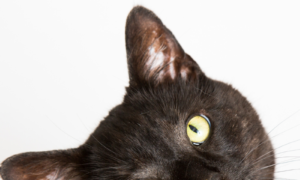By Ann Acker for The Daily Cat

When it comes to fun, there’s almost nothing cats love more than to watch the world from above. Unfortunately, they often like to perch where they don’t belong, like atop bookcases and dressers, where things can easily get broken.
Keeping a cat grounded can be a challenge, but it really is in your pet’s best interest. Your cat could hurt himself by getting tangled on something while jumping from the chair to the dresser, or by leaping onto that not-so-stable plant stand.
Keeping Your Stuff in Place
Try these cat training strategies for controlling your pet’s natural need to leap.
- Remove its launch pad If your cat is able to get onto a high bookcase by leaping from a nearby chair, move the chair. Without this launch pad, the cat is no longer able to reach its perch.
- Use a doorknob alarm on your drapes When pinned to the drapes, the alarm will sound every time your cat tries to use your drapes as a ladder. Another solution may be to replace fabric drapes with vertical blinds.
- Place obstacles along the path A couple of strategically placed potted plants or large books can work wonders in keeping cats off shelves and dresser tops.
- Give your cat a solid place to land with a freestanding cat perch Most retail pet stores sell them, and they’re easy to assemble. You could even build one yourself.
- Consider a window perch for your feline friend You can put them together quickly, and they’ll give your cat hours of entertainment — especially if you place a bird or squirrel feeder in the yard outside the window. Make sure the window is locked and reinforced so your pet won’t fall out.
Cleaning Up Your Cat’s Climbing Habits
If your cat doesn’t get the message and continues to climb, don’t lose hope. The next step is to try startling him into behaving better with a whistle or a beanbag, or an empty soda can with a few pennies inside (I’ve tried it and it works well). The key is to make sure your cat doesn’t come to associate you with the noise or sudden motion. If he does, he may become frightened or continue the bad behavior behind your back.
Try these ideas for taming your cat’s climbing ways:
- Don’t make eye contact with your cat when you use a noisemaker. Every time you see the cat start to climb, give a quick toss of the soda can or toss the beanbag near the animal (not at it) then walk away. You want to make the consequence of this behavior unpleasant, not terrifying.
- Try temporarily putting foil on the furniture. The sound or texture will be unpleasant.
- Buy a motion detector that sounds an alarm every time your cat enters the forbidden area. For best results, get the kind that resets itself after every use.
- Don’t scream at or strike your cat when he is perching in a place he doesn’t belong. Physical punishment can sometimes adversely affect your relationship and lead to other destructive behaviors.
- Don’t startle your high-minded cat with a noisemaker when he’s perched near something breakable. This could cause the animal to jump in fear, knock the object over, and get hurt in the process.
The overall goal is to find a balance between your natural need to keep plants upright, and your cat’s natural need climb. With these strategies and a little bit of time, you and your cat can live together in harmony.
Ann Acker is a freelance writer and editor on subjects ranging from cat healthcare to feline antics.





